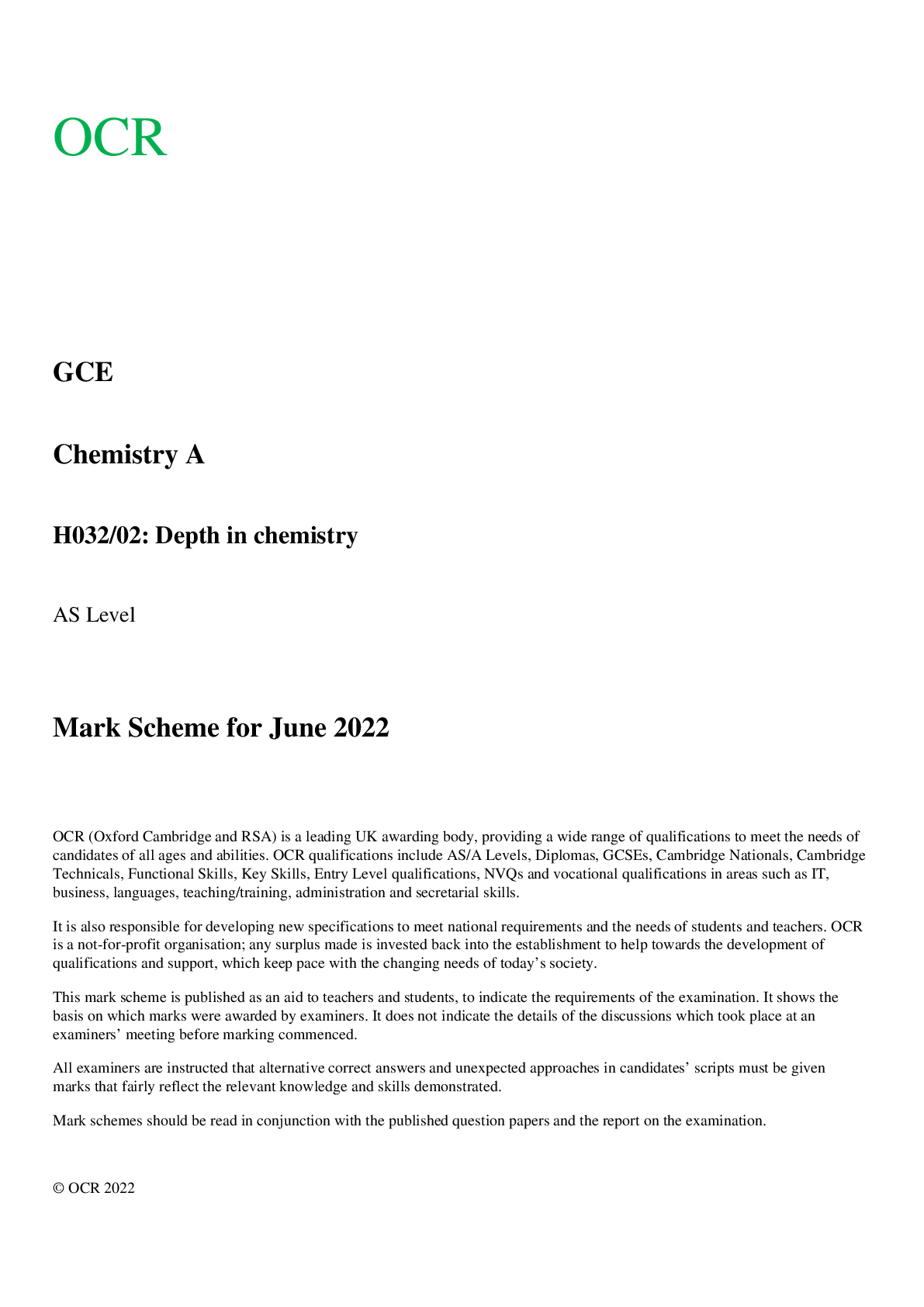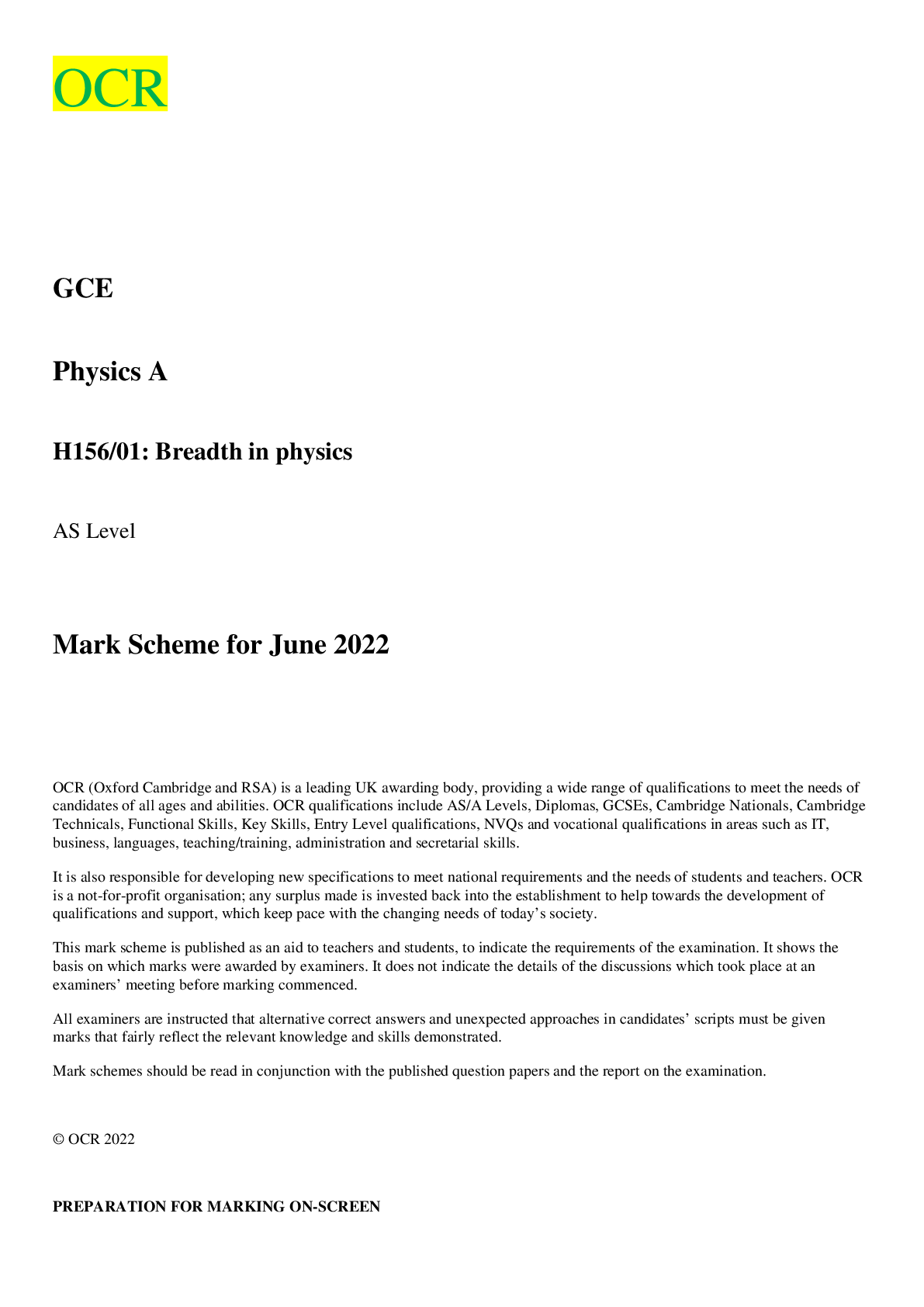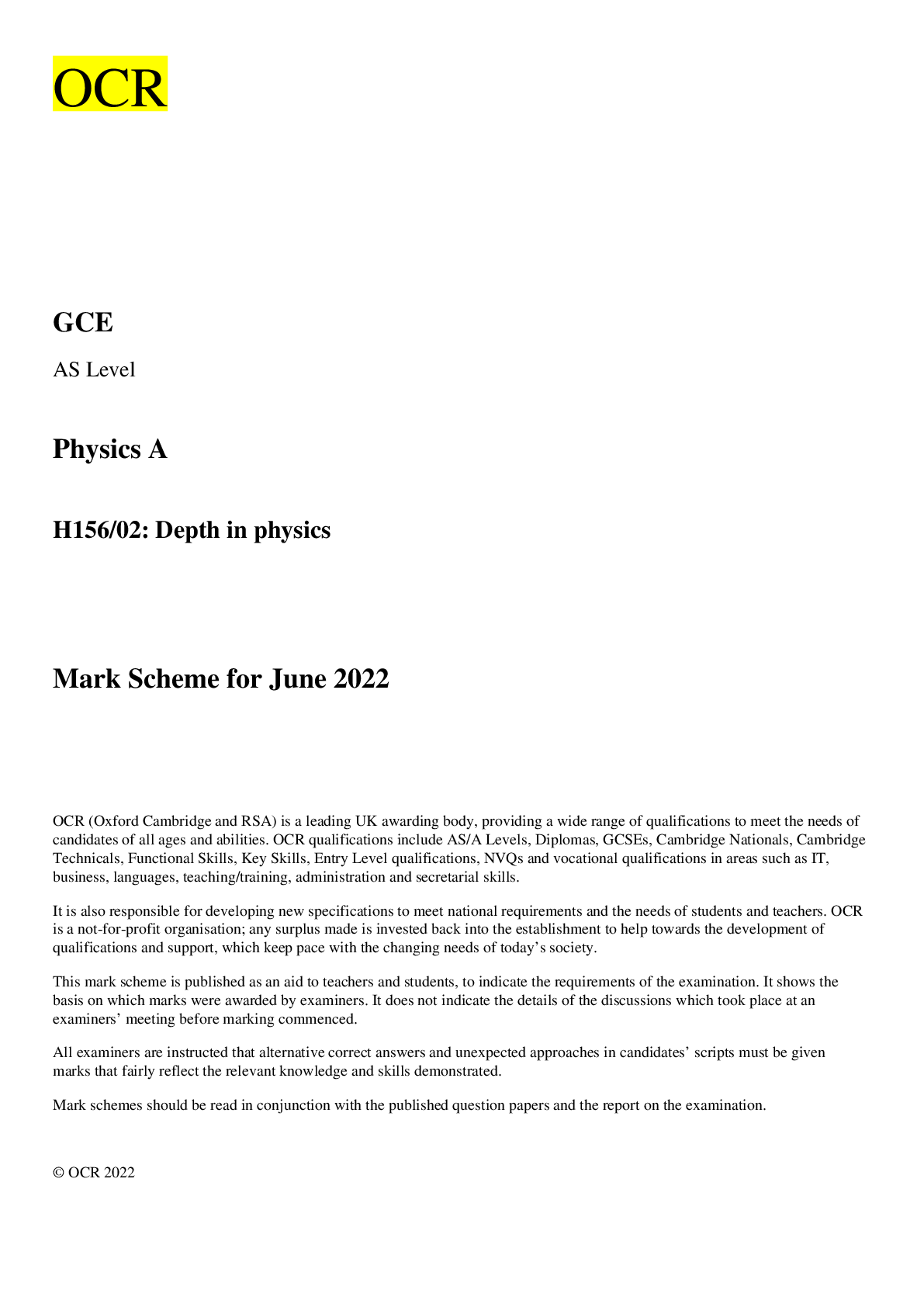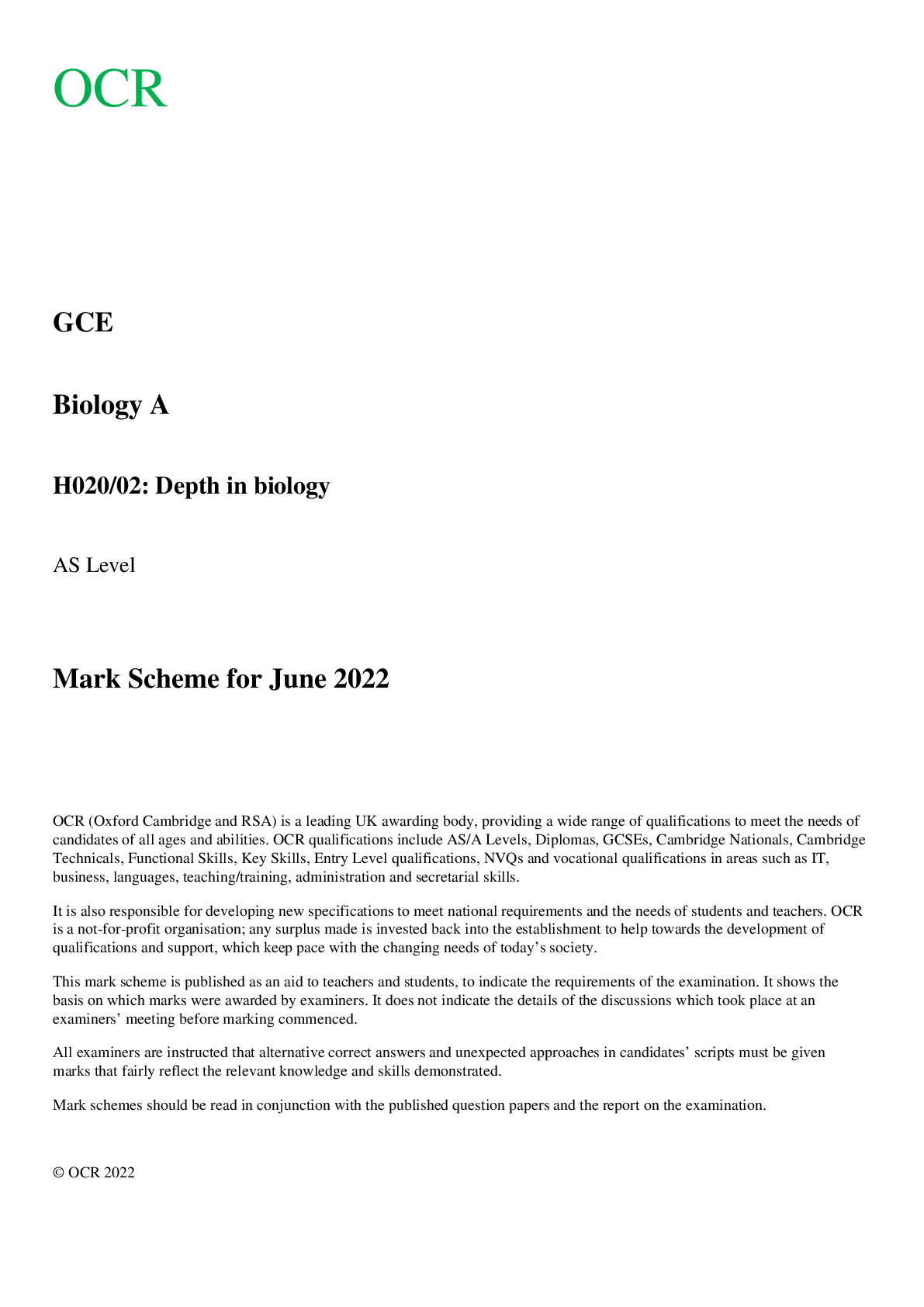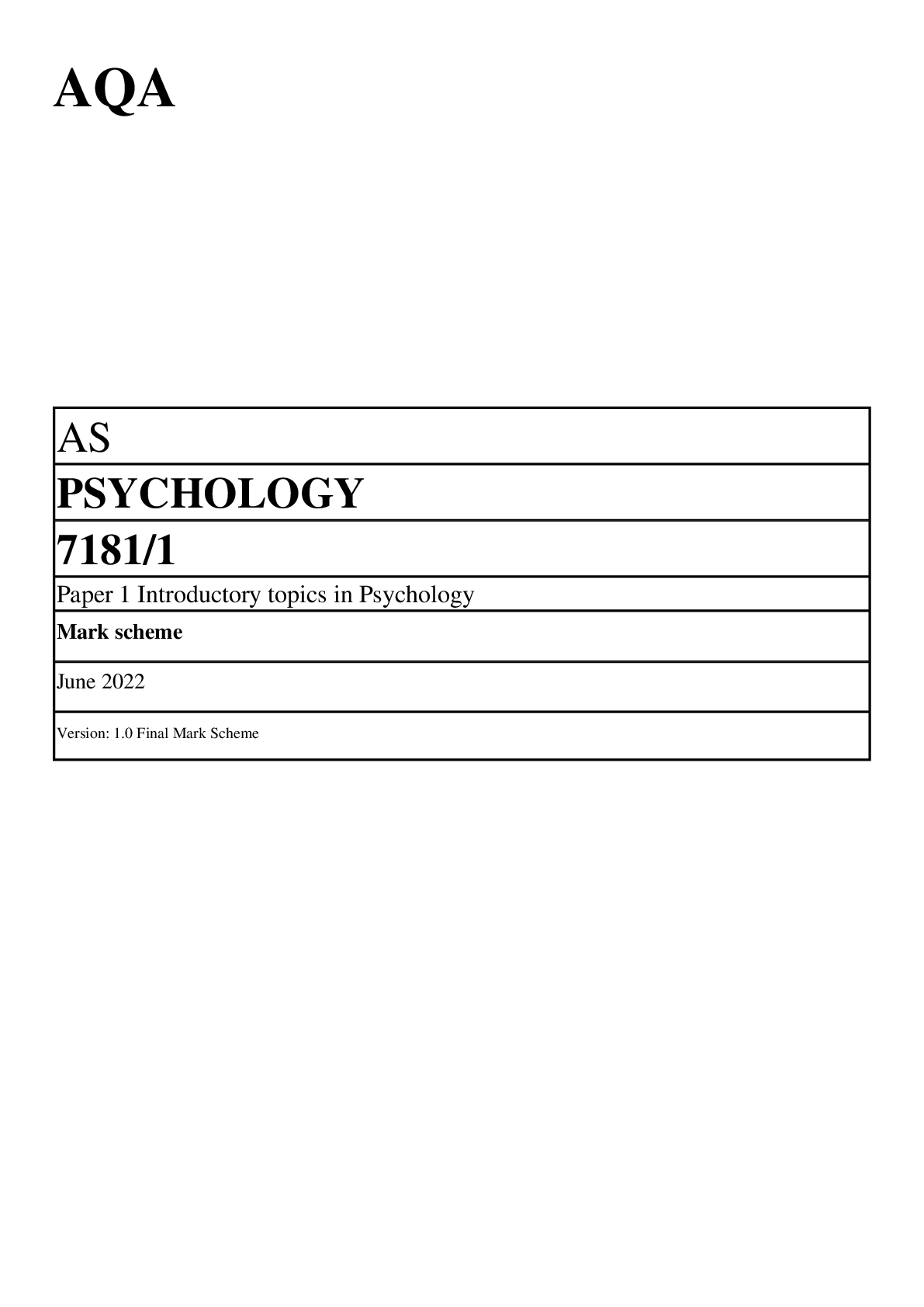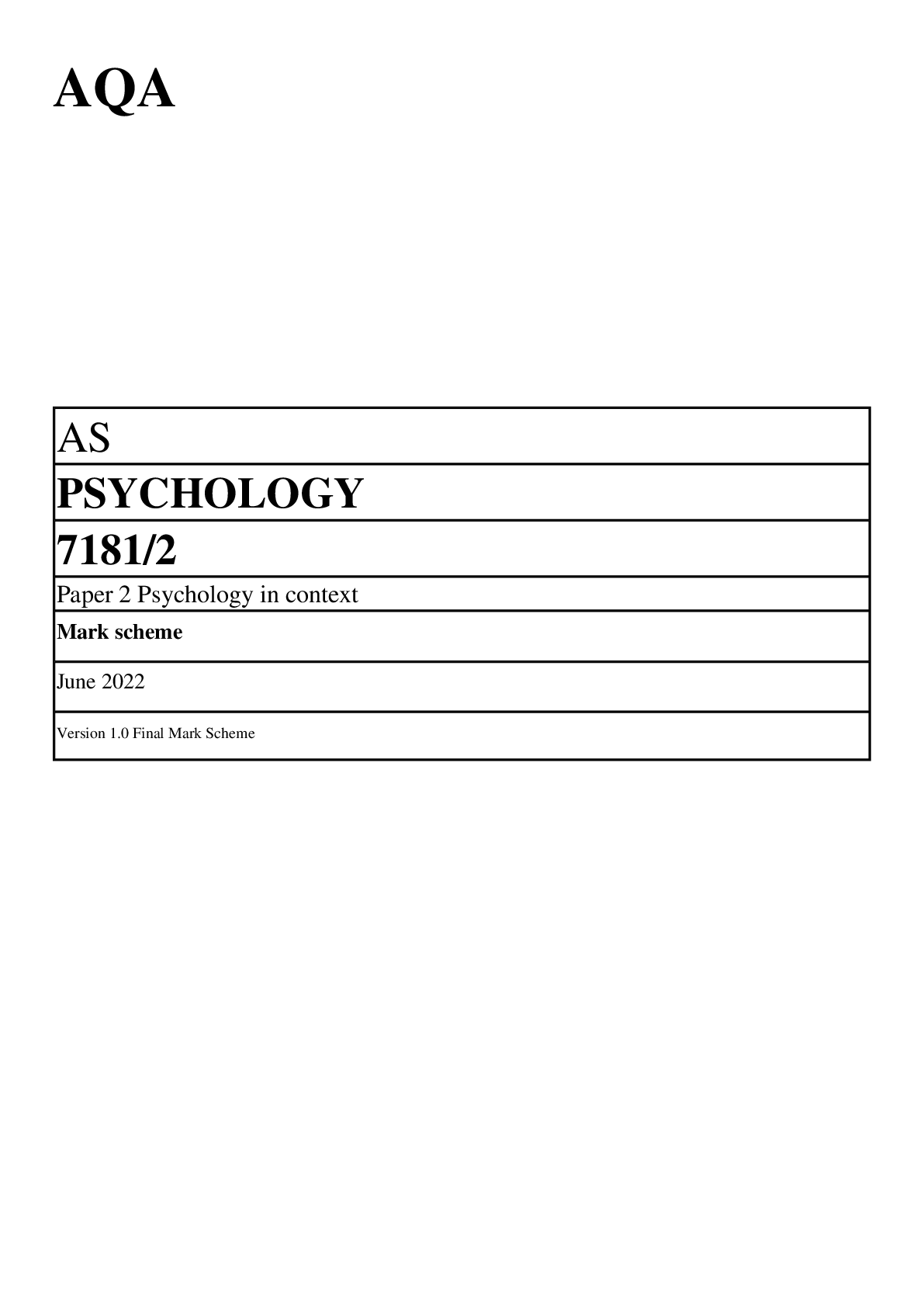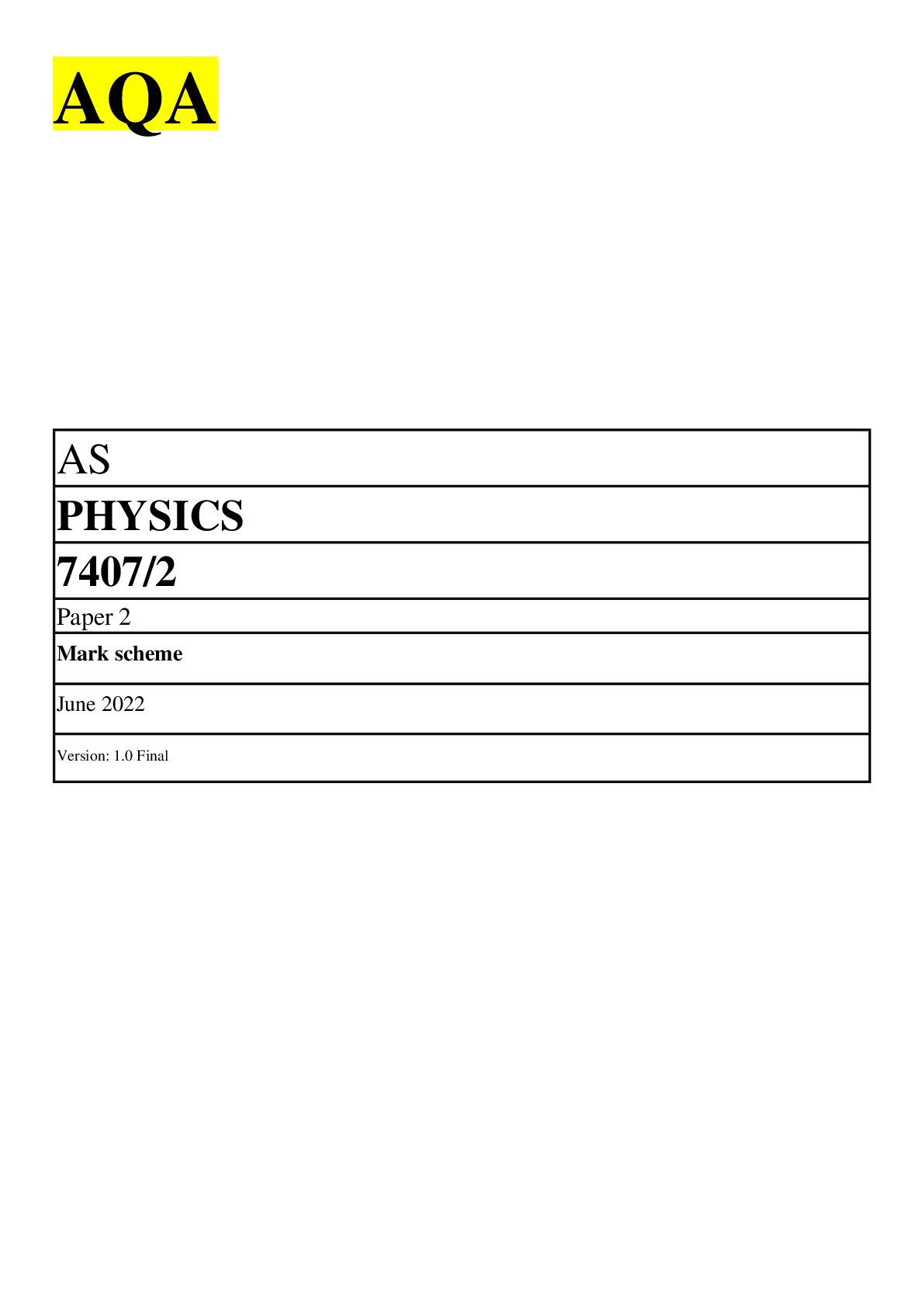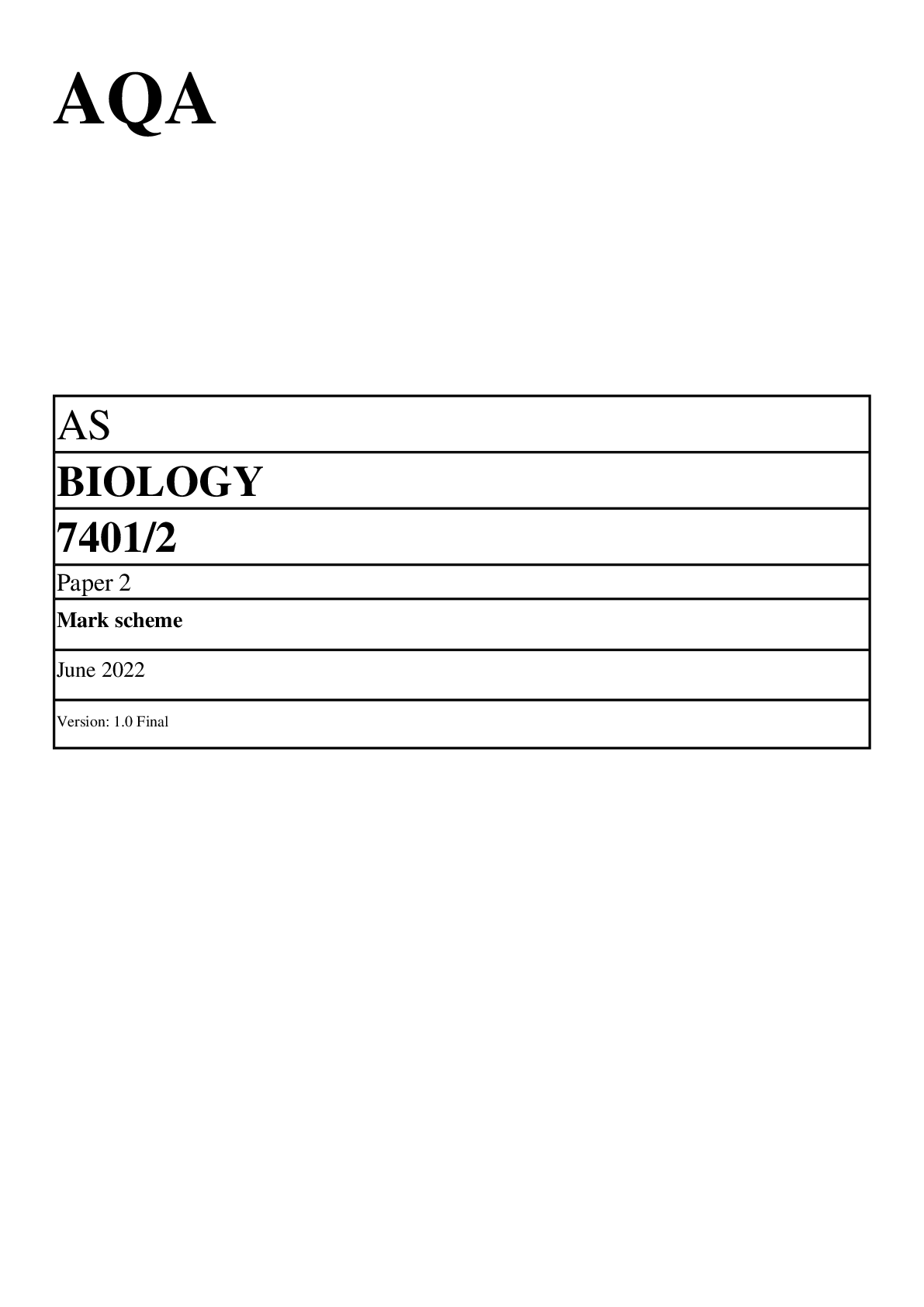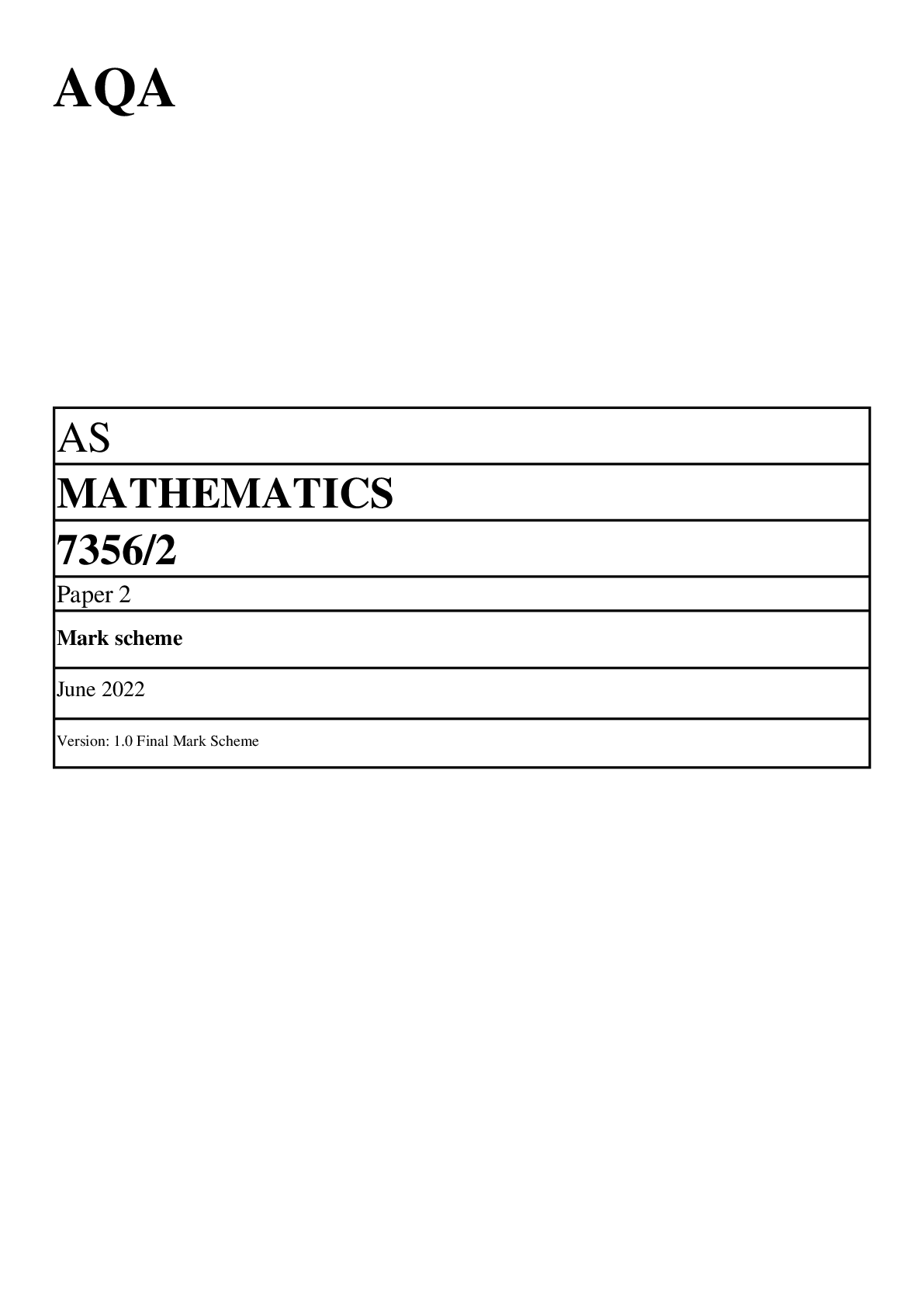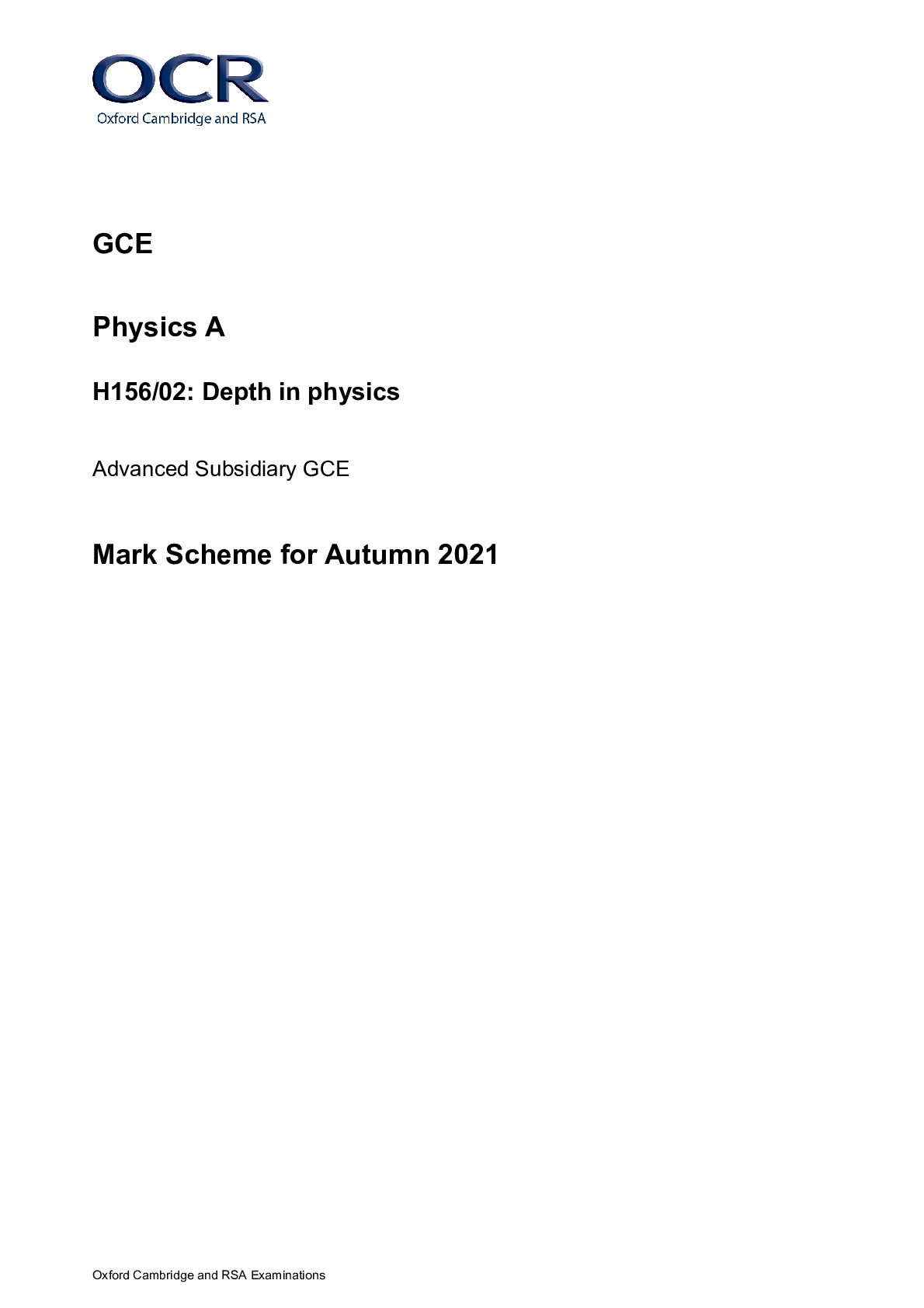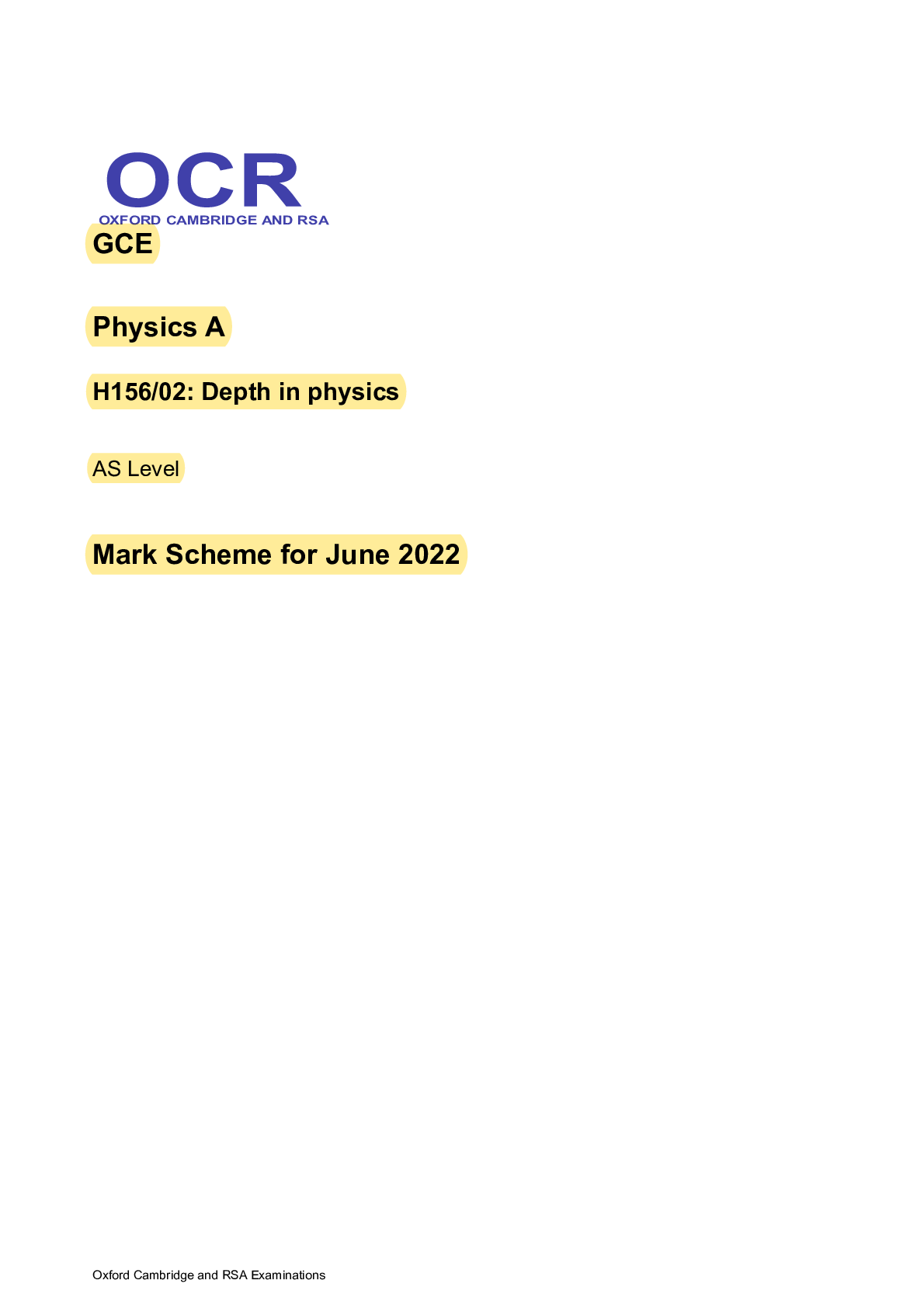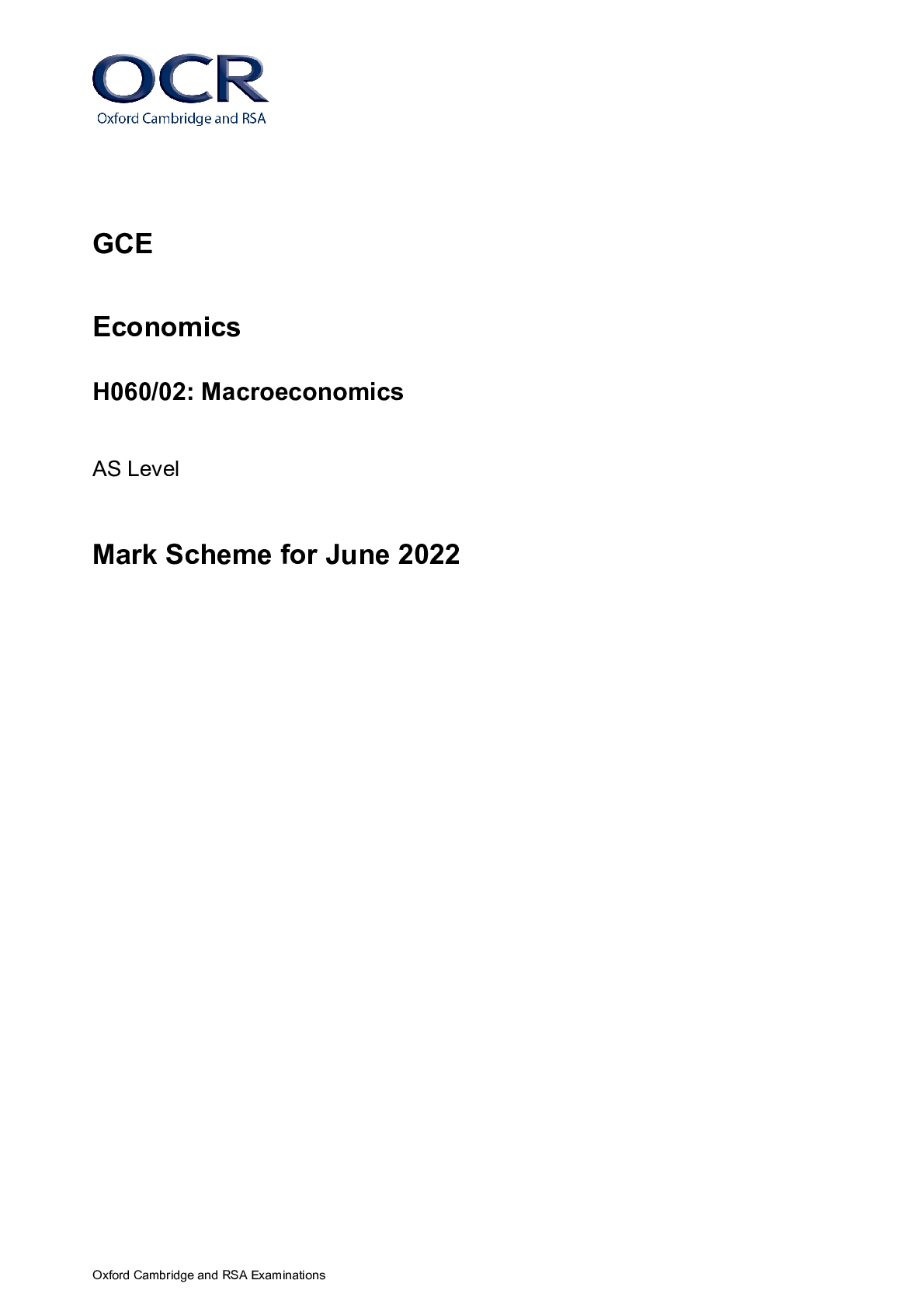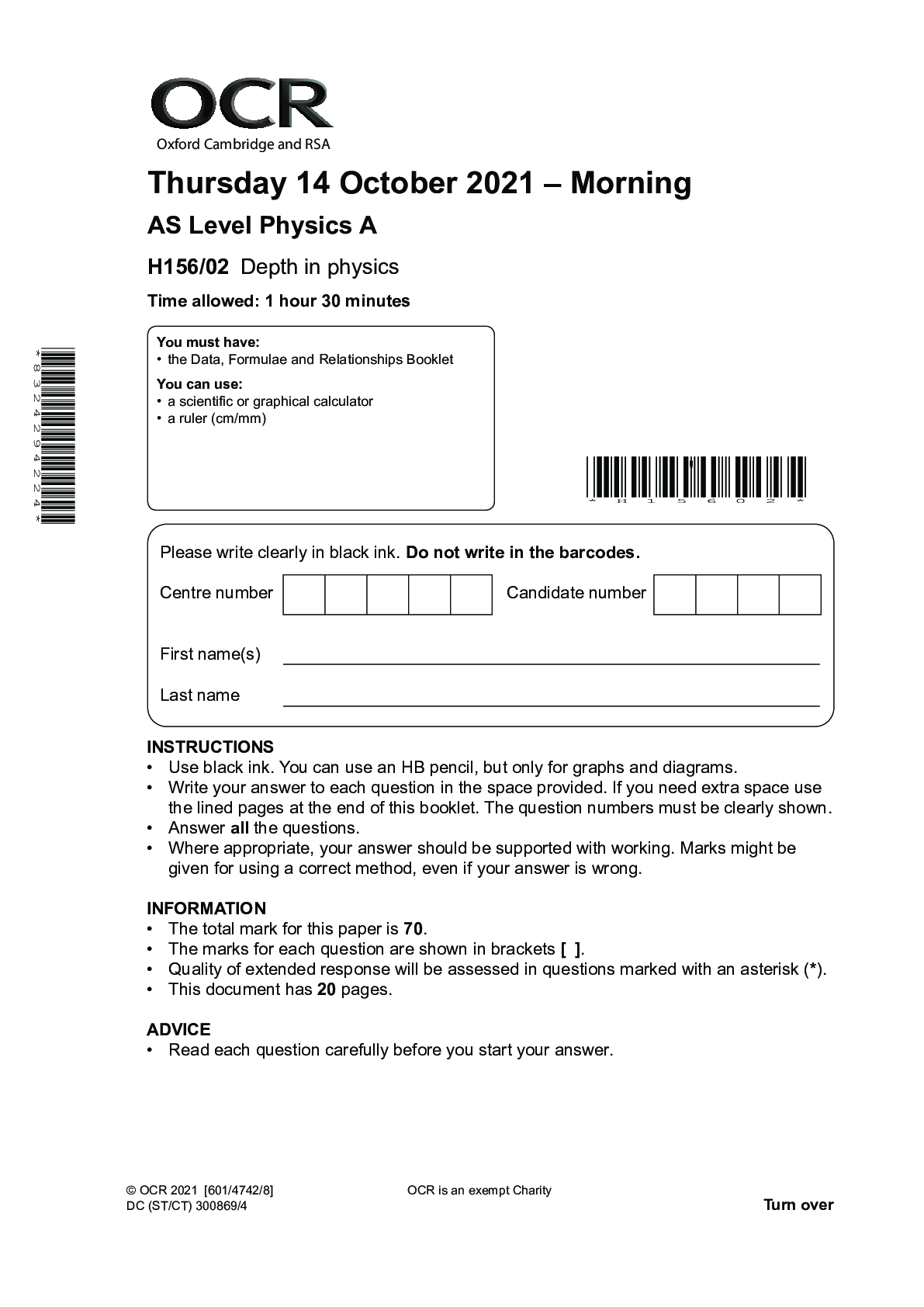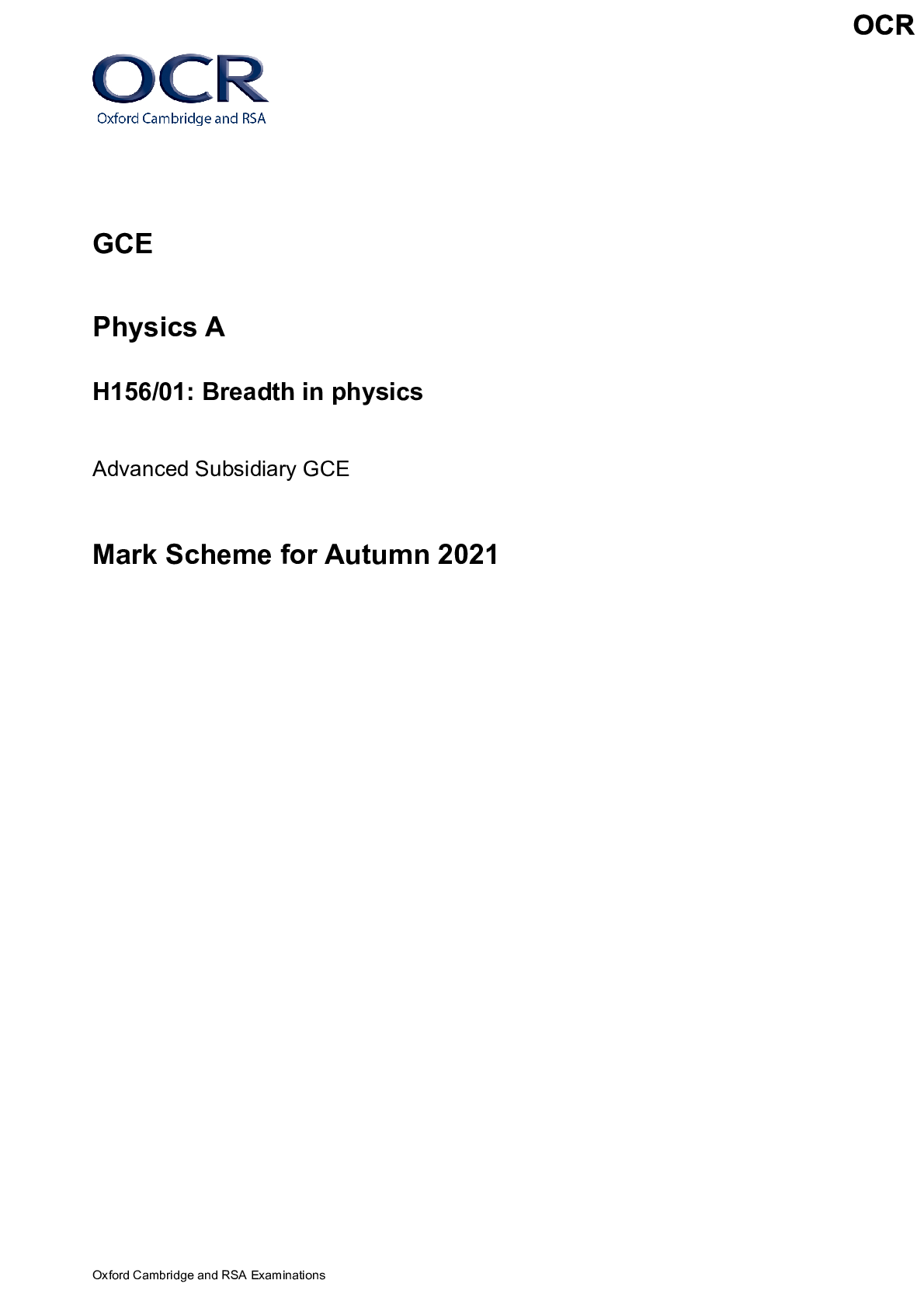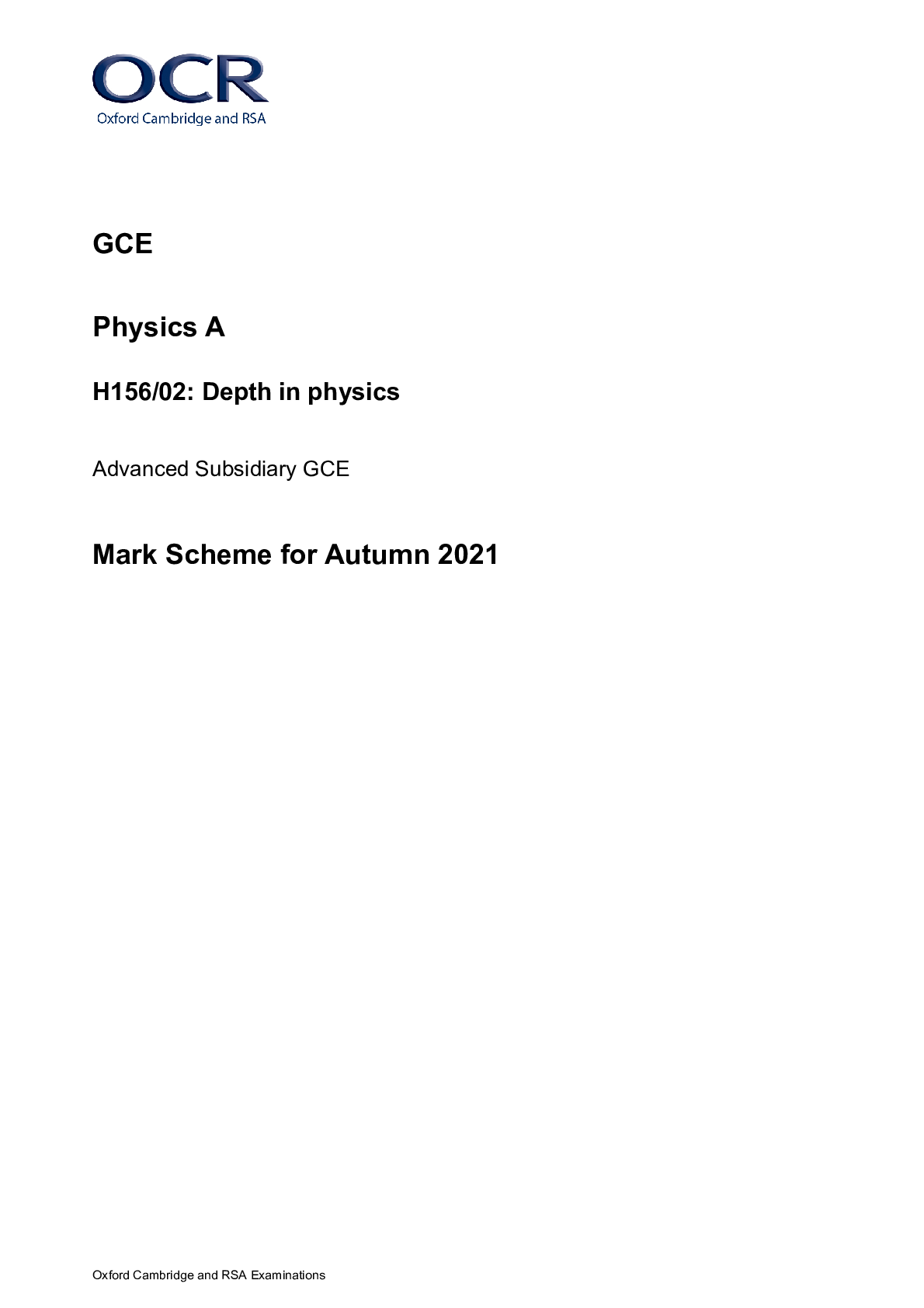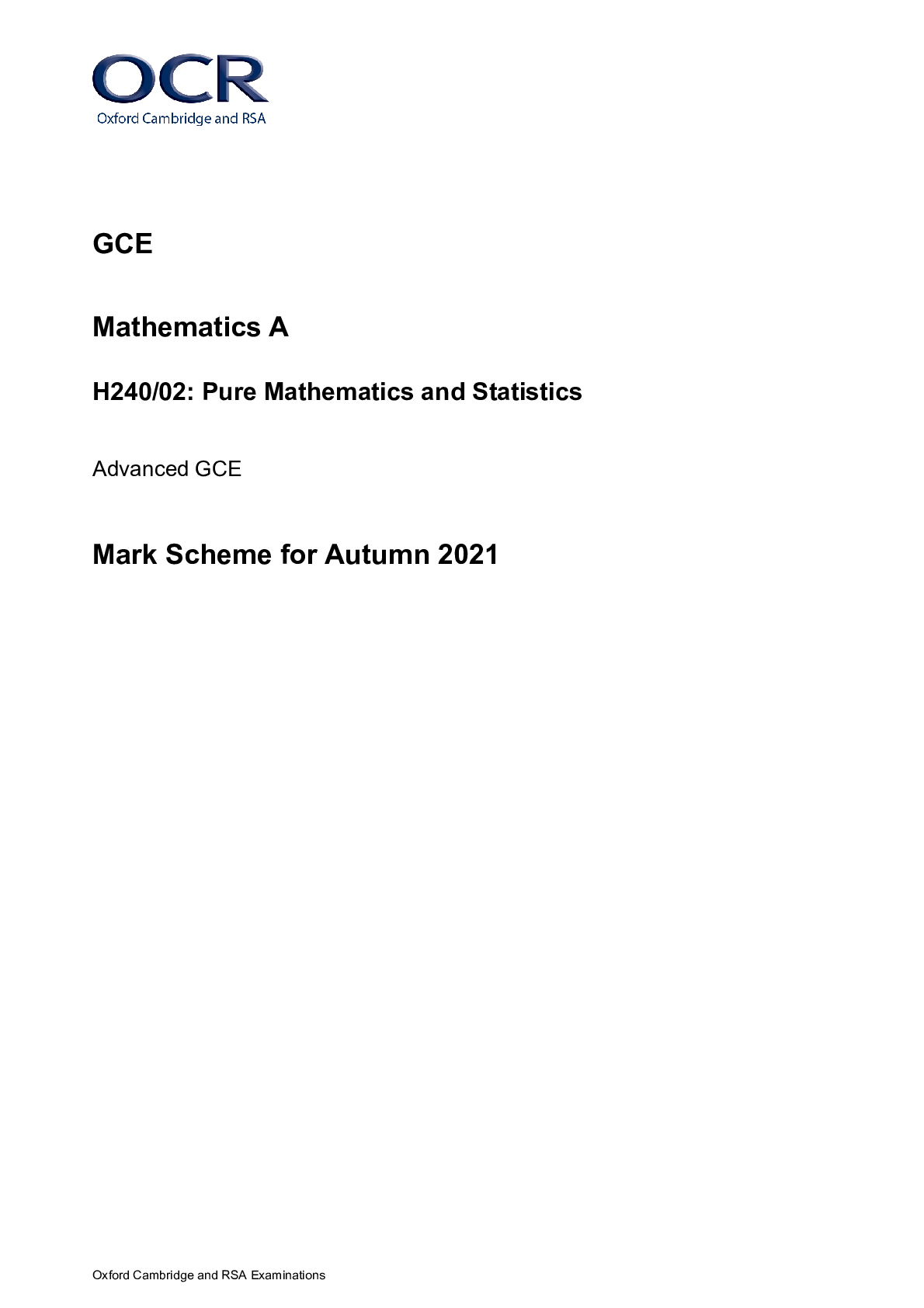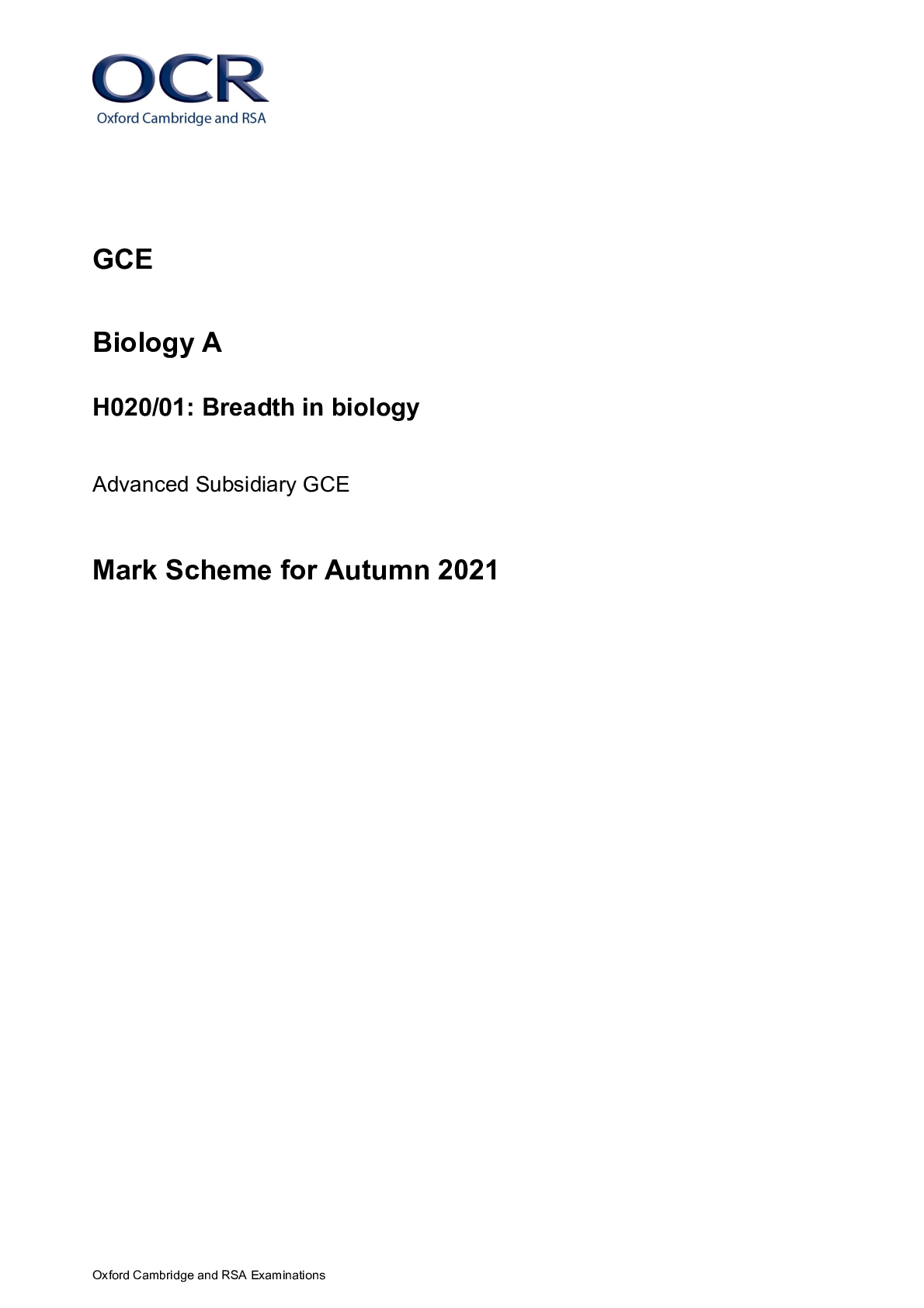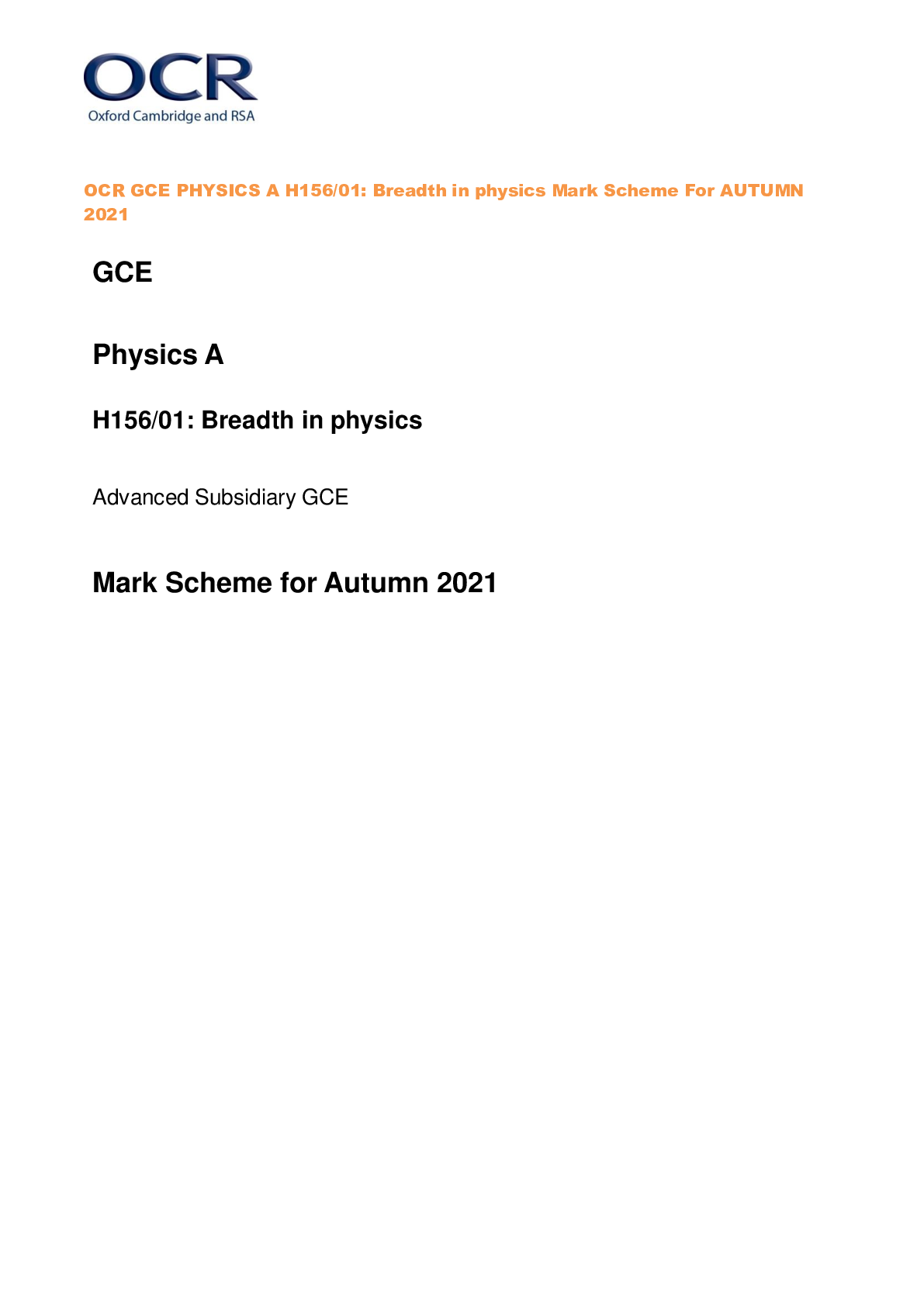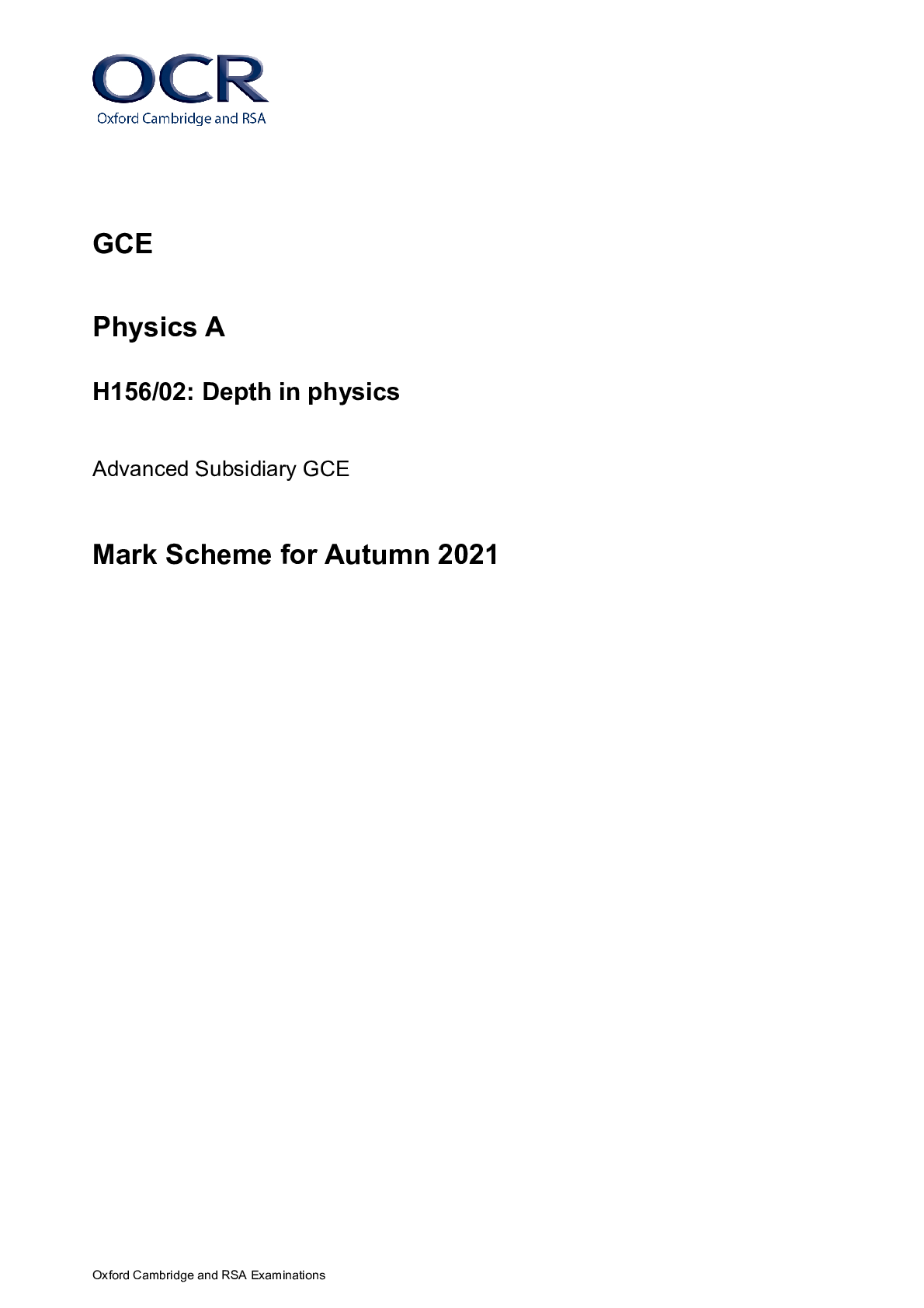OCR > AS Level Mark Scheme > OCR AS Level Physics A H156/02: Depth in physics Mark Scheme for June 2022 (All)
OCR AS Level Physics A H156/02: Depth in physics Mark Scheme for June 2022
Document Content and Description Below
AS Level Physics A H156/02: Depth in physics Mark Scheme for June 2022 OCR (Oxford Cambridge and RSA) is a leading UK awarding body, providing a wide range of qualifications to me... et the needs of candidates of all ages and abilities. OCR qualifications include AS/A Levels, Diplomas, GCSEs, Cambridge Nationals, Cambridge Technicals, Functional Skills, Key Skills, Entry Level qualifications, NVQs and vocational qualifications in areas such as IT, business, languages, teaching/training, administration and secretarial skills. It is also responsible for developing new specifications to meet national requirements and the needs of students and teachers. OCR is a not-for-profit organisation; any surplus made is invested back into the establishment to help towards the development of qualifications and support, which keep pace with the changing needs of today’s society. This mark scheme is published as an aid to teachers and students, to indicate the requirements of the examination. It shows the basis on which marks were awarded by examiners. It does not indicate the details of the discussions which took place at an examiners’ meeting before marking commenced. All examiners are instructed that alternative correct answers and unexpected approaches in candidates’ scripts must be given marks that fairly reflect the relevant knowledge and skills demonstrated. Mark schemes should be read in conjunction with the published question papers and the report on the examination. © OCR 2022 PREPARATION FOR MARKING ON-SCREEN 1. Make sure that you have accessed and completed the relevant training packages for on-screen marking: RM assessor Online Training and the OCR Essential Guide to Marking. 2. Make sure that you have read and understood the Instructions for On-Screen Marking and the mark scheme and the question paper for this unit. These are posted on the RM Cambridge Assessment Support Portal http://www.rm.com/support/ca 3. Log-in to RM assessor and mark the required number of practice responses and the required number of standardisation responses. MARKING INSTRUCTIONS – FOR MARKING ON-SCREEN AND FOR PAPER BASED MARKING 1. Mark strictly to the mark scheme. 2. Marks awarded must relate directly to the marking criteria. 3. The schedule of dates is very important. It is essential that you meet the RM assessor 50% and 100% deadlines. If you experience problems, you must contact your Team Leader without delay. 4. If you are in any doubt about applying the mark scheme, consult your Team Leader by telephone or the RM assessor messaging system, or by email. 5. Crossed Out Responses Where a candidate has crossed out a response and provided a clear alternative then the crossed out response is not marked. Where no alternative response has been provided, examiners may give candidates the benefit of the doubt and mark the crossed out response where legible. Multiple Choice Question Responses When a multiple choice question has only a single, correct response and a candidate provides two responses (even if one of these responses is correct), then no mark should be awarded (as it is not possible to determine which was the first response selected by the candidate). When a question requires candidates to select more than one option/multiple options, then local marking arrangements need to ensure consistency of approach. Contradictory Responses When a candidate provides contradictory responses, then no mark should be awarded, even if one of the answers is correct. Short Answer Questions (requiring only a list by way of a response, usually worth only one mark per response) Where candidates are required to provide a set number of short answer responses then only the set number of responses should be marked. The response space should be marked from left to right on each line and then line by line until the required number of responses have been considered. The remaining responses should not then be marked. Examiners will have to apply judgement as to whether a ‘second response’ on a line is a development of the ‘first response’, rather than a separate, discrete response. (The underlying assumption is that the candidate is attempting to hedge their bets and therefore getting undue benefit rather than engaging with the question and giving the most relevant/correct responses.) Short Answer Questions (requiring a more developed response, worth two or more marks) If the candidates are required to provide a description of, say, three items or factors and four items or factors are provided, then mark on a similar basis – that is downwards (as it is unlikely in this situation that a candidate will provide more than one response in each section of the response space.) Longer Answer Questions (requiring a developed response) Where candidates have provided two (or more) responses to a medium or high tariff question which only required a single (developed) response and not crossed out the first response, then only the first response should be marked. Examiners will need to apply professional judgement as to whether the second (or a subsequent) response is a ‘new start’ or simply a poorly expressed continuation of the first response. 6. On each blank page the icon BP must be inserted to confirm that the page has been checked. For additional objects (if present), a tick must be inserted on each page to confirm that it has been checked. Always check the pages (and additional objects if present) at the end of the response in case any answers have been continued there. 7. Award No Response (NR) if: • there is nothing written in the answer space Award Zero ‘0’ if: • anything is written in the answer space and is not worthy of credit (this includes text and symbols). The hash key (#) on your keyboard will enter NR. Note: Award 0 marks – for an attempt that earns no credit (including copying out the question) Team Leaders must confirm the correct use of the NR button with their markers before live marking commences and should check this when reviewing scripts. 8. The RM assessor comments box is used by your team leader to explain the marking of the practice responses. Please refer to these comments when checking your practice responses. Do not use the comments box for any other reason. If you have any questions or comments for your team leader, use the phone, the scoris messaging system, or e-mail. 9. Level of response (LoR) Read through the whole answer from start to finish, concentrating on features that make it a stronger or weaker answer using the indicative scientific content as guidance. The indicative scientific content indicates the expected parameters for candidates’ answers, but be prepared to recognise and credit unexpected approaches where they show relevance. Using a ‘best-fit’ approach based on the science content of the answer, first decide which set of level descriptors, Level 1 (L1), Level 2 (L2) or Level 3 (L3), best describes the overall quality of the answer using the guidelines described in the level descriptors in the mark scheme. Once the level is located, award the higher or lower mark. The higher mark should be awarded where the level descriptor has been evidenced and all aspects of the communication statement (in italics) have been met. The lower mark should be awarded where the level descriptor has been evidenced but aspects of the communication statement (in italics) are missing. In summary: • the science content determines the level • the communication statement determines the mark within a level. Levels of response questions on this paper are 2 and 8. 10. Here are the subject specific instructions for this question paper. CATEGORISATION OF MARKS The marking schemes categorise marks on the MACB scheme. B marks These are awarded as independent marks, which do not depend on other marks. For a B-mark to be scored, the point to which it refers must be seen specifically in the candidate’s answers. M marks These are method marks upon which A-marks (accuracy marks) later depend. For an M-mark to be scored, the point to which it refers must be seen in the candidate’s answers. If a candidate fails to score a particular M-mark, then none of the dependent A-marks can be scored. C marks These are compensatory method marks which can be scored even if the points to which they refer are not written down by the candidate, providing subsequent working gives evidence that they must have known it. For example, if an equation carries a C-mark and the candidate does not write down the actual equation but does correct working which shows the candidate knew the equation, then the C-mark is given. A marks These are accuracy or answer marks, which either depend on an M-mark, or allow a C-mark to be scored. SIGNIFICANT FIGURES If the data given in a question is to 2 sf, then allow an answer to 2 or more significant figures. If an answer is given to fewer than 2 sf, then penalise once only in the entire paper. Any exception to this rule will be mentioned in the Additional Guidance. 11. Annotations available in RM Assessor Annotation Meaning Correct response Used to indicate the point at which a mark has been awarded (one tick per mark awarded). Incorrect response Used to indicate an incorrect answer or a point where a mark is lost. AE Arithmetic error Do not allow the mark where the error occurs. Then follow through the working/calculation giving full subsequent ECF if there are no further errors. BOD Benefit of doubt given Used to indicate a mark awarded where the candidate provides an answer that is not totally satisfactory, but the examiner feels that sufficient work has been done. BP Blank page Use BP on additional page(s) to show that there is no additional work provided by the candidates. CON Contradiction No mark can be awarded if the candidate contradicts himself or herself in the same response. ECF Error carried forward Used in numerical answers only, unless specified otherwise in the mark scheme. Answers to later sections of numerical questions may be awarded up to full credit provided they are consistent with earlier incorrect answers. Within a question, ECF can be given for AE, TE and POT errors but not for XP. L1 Level 1 L1 is used to show 2 marks awarded and L1^ is used to show 1 mark awarded. L2 Level 2 L2 is used to show 4 marks awarded and L2^ is used to show 3 marks awarded. L3 Level 3 L3 is used to show 6 marks awarded and L3^ is used to show 5 marks awarded. POT Power of 10 error This is usually linked to conversion of SI prefixes. Do not allow the mark where the error occurs. Then follow through the working/calculation giving ECF for subsequent marks if there are no further errors. SEEN Seen To indicate working/text has been seen by the examiner. SF Error in number of significant figures Where more SFs are given than is justified by the question, do not penalise. Fewer significant figures than necessary will be considered within the mark scheme. Penalised only once in the paper. TE Transcription error This error is when there is incorrect transcription of the correct data from the question, graphical read-off, formulae booklet or a previous answer. Do not allow the relevant mark and then follow through the working giving ECF for subsequent marks. XP Wrong physics or equation Used in numerical answers only, unless otherwise specified in the mark scheme. Use of an incorrect equation is wrong physics even if it happens to lead to the correct answer. ^ Omission Used to indicate where more is needed for a mark to be awarded (what is written is not wrong but not enough). Abbreviations, annotations and conventions used in the detailed Mark Scheme (to include abbreviations and subject-specific conventions). Annotation Meaning / alternative and acceptable answers for the same marking point Reject Answers which are not worthy of credit Not Answers which are not worthy of credit Ignore Statements which are irrelevant Allow Answers that can be accepted ( ) Words which are not essential to gain credit Underlined words must be present in answer to score a mark ECF Error carried forward AW Alternative wording ORA Or reverse argument General rule: For substitution into an equation, allow any subject – unless stated otherwise in the guidance Question Answer Marks Guidance 1 (a) Use a micrometer / caliper (to measure the diameter of the ball) Repeat readings in different directions and average r = (mean) diameter 2 B1 B1 B1 Ignore radius Allow places / points / positions for directions AW (b) 169 − 96 73 ? = or 87 87 0.169 − 0.096 0.073 ? = or 87 × 10−6 87 × 10−6 ? (= 839) = 840 (kg m–3) C1 Ignore power of tens M1 Note power of tens must be seen for both mass and volume A0 (c) −3 3 volume =4π(8.1×10 ) or 2.226 × 10–6 (m3) 3 OR 840 × 9.81 × candidate’s volume 840 × 9.81 × 2.226 × 10–6 or 0.0183 0.018 (N) C1 Ignore power of tens M1 A0 (d) (i) Terminal velocity is when the velocity is constant B1 Allow acceleration is zero for velocity is constant (Terminal) velocity is determined from the gradient B1 when graph is a straight line / constant gradient OR evidence of calculation of gradient of straight section B1 Check read-offs are appropriate. Question Answer Marks Guidance (ii) Tangent drawn at t = 0.2 s extends at least two large squares (0.2 s) in the x-direction 1.2 (m s–1) M1 A1 Allow 1.10 (m s–1) to 1.30 (m s–1) (e) 0.017 × 9.81 − 0.018 0.14877 ? = (= ) 6? × 8.1 × 10−3 × 1.8 6? × 8.1 × 10−3 × 1.8 0.54 kg m-1 s-1 OR N s m-2 OR Pa s C1 A1 Allow 0.55 Note for power of ten errors 607 or 0.607 or 5.4 × 10–4 scores one mark B1 Total 15 [Show More]
Last updated: 11 months ago
Preview 1 out of 16 pages

Also available in bundle (1)

OCR AS LEVEL PHYSICS A PAPER 2 JUNE 2022 FINAL QUESTION PAPER AND MARK SCHEME.
OCR AS LEVEL PHYSICS A PAPER 2 JUNE 2022 FINAL QUESTION PAPER AND MARK SCHEME.
By examstore001 11 months ago
$28
2
Reviews( 0 )
Document information
Connected school, study & course
About the document
Uploaded On
May 17, 2023
Number of pages
16
Written in
Additional information
This document has been written for:
Uploaded
May 17, 2023
Downloads
0
Views
152

